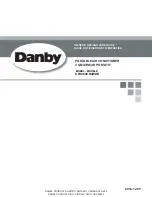
YORK
5587001-YSG-A-520 | Start-Up & Operation Guide
62
Smoke Control
The rooftop unit contains a sequence called smoke
control, which uses three operating scenarios:
• Purge
• Pressurization
• Depressurize
Smoke control sequences are typically used when a
building experiences a fire/smoke incident and are not
a normal operating sequence.
During smoke control operation, all unit cooling, heat-
ing, and other normal sequences shut down until the
smoke control operation is complete.
The unit has three inputs for field wiring to be landed
on the building system interface board: SAFETY-1,
SAFETY-2, and SAFETY-3. Each input can be select-
ed for one of the smoke control sequences. 24 VAC
applied to any of the smoke control inputs immediately
places the unit into that smoke control scenario.
Purge
Purge is used to flush the building with 100% outside
air using the sequence below:
• Supply fan is turned ON
• When the unit type is MZVAV, the supply fan is
controlled to the active duct static setpoint, and
the MZVAV heat command relay is turned ON
• When the unit type is SZVAV, the supply fan
runs at 100%
• Return/exhaust fan is turned ON and operated at
100%
• Outside air damper is driven to 100% open
• Return damper is driven to 100% closed
• Exhaust damper is driven to 100% open
Pressurization
Pressurization is used to pressurize the building with
outside air and force the air inside the space through
the walls into adjacent spaces or outside the building.
Pressurization uses the following sequence:
• Supply fan is turned ON
• When the unit type is MZVAV, the supply fan is
controlled to the active duct static setpoint, and
the MZVAV heat command relay is turned ON
• When the unit type is SZVAV, the supply fan
runs at 100%
• Return/exhaust fan is turned OFF
• Outside air damper is driven 100% open
• Return damper is driven 100% closed
• Exhaust damper is driven 100% closed
Depressurize
Depressurize mode is used to evacuate the air inside
the building without introducing any outside air using
the sequence below.
• Supply fan is turned OFF
• Return/exhaust fan is turned ON and operated at
100%
• Outside air damper is driven 100% closed
• Return damper is driven to 100% open
• Exhaust damper is driven 100% open
User Interface Display
The standard user interface display is organic light-
emitting diode (OLED) with green characters on a
black background providing high visibility. The display
provides a minimum of 175 characters in total with 35
characters × 5 lines. The OLED display is a 256 × 64
dot matrix.
The OLED display shows animated text, symbols, and
descriptions down to -40.0°F (-40.0°C) without notice-
able degradation of contrast or display response time.
Numeric data is available in imperial or metric units. A
sealed, membrane style keypad with keys is used to
navigate the unit controller and enter data.
An optional color wide screen, thin film transistor (TFT)
with multi-touch capacitive touchscreen and 1280
× 800 resolution is also available to order factory in-
stalled or to field install. The touchscreen display de-
tails all operations and parameters using an interactive
graphical representation of the rooftop unit and its ma-
jor components.
The software on the user interface is upgradable in the
field using the USB port provided on the main control
board.
Menu Navigation
Screen Layout –
The display has multiple menu and
sub-menu screens that provide easy navigation. The
display is configured into Status, Alarms, Alarm Log,
Summary, Commission, Controller, Update, Details,
Schedule, and Start-Up Wizard menu options.
















































